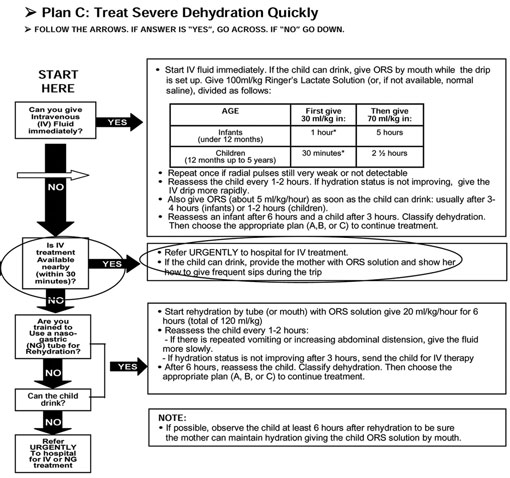Severe dehydration
Any child with dehydration needs fluid replacement. A child classified with severe dehydration needs fluids quickly. ‘Plan C: Treat Severe Dehydration Quickly’ describes how to give fluids to severely dehydrated children and is set out in Box 5.3 below.
Note that giving intravenous (IV) fluid therapy through a sterile tube and cannula into a small child’s vein requires special training in addition to any training you may have received on giving IV fluids to adults.
Box 5.3 Plan C: Steps for treating severe dehydration

Activity 5.2 Steps for treating severe dehydration
Look at the information in Box 5.3 and then make notes in your Study Diary in answer to the following questions.
- When should you refer a child urgently to hospital for treatment?
- If there is no IV line available, or you have not been trained to insert one, what options could you follow?
- How often would you assess the child after rehydration? Give reasons for your answer.
You can see that the guidance in Box 5.3 sets out a series of questions that take you through a range of options depending on your training and what resources are available in your health post, such as IV fluids or naso-gastric (NG) tube. The essential points are these:
- A child with severe dehydration needs to be treated as quickly as possible.
- If you are not able to rehydrate the child using an IV line, naso-gastric tube, or because the child is unable to take fluids by mouth, you must refer the child urgently to a hospital.
- If there is an IV facility which the mother can reach in less than 30 minutes you should refer the child urgently, giving sips of ORS during the trip.
- If the health facility is more than 30 minutes away you should still refer if you are not able to rehydrate the child using a naso-gastric tube or orally.
- If you are able to rehydrate the child but his hydration status does not improve after three hours, you should refer the child.
You are now going to look at how to treat a child classified with some dehydration.